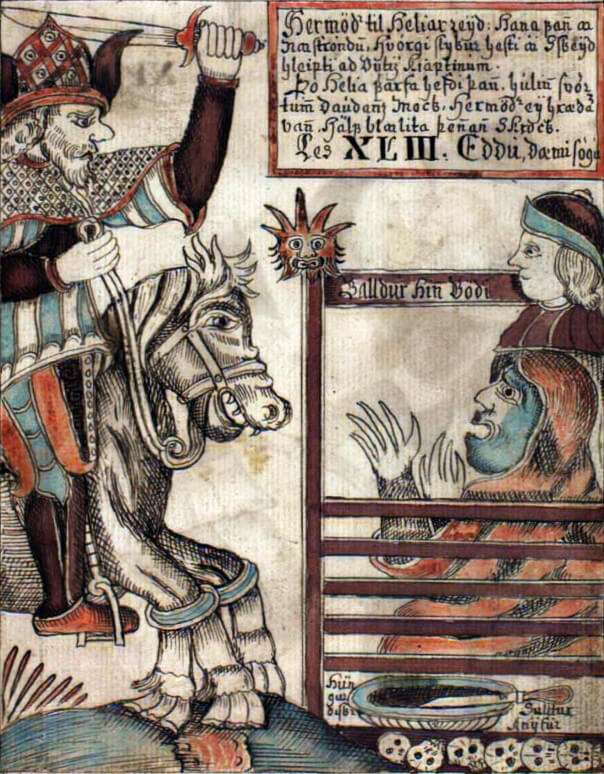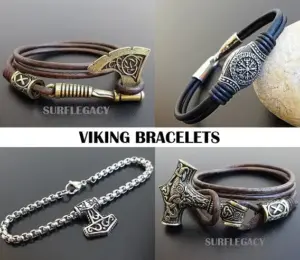In Norse mythology, Hermod is a figure who stands out for his speed and role as a messenger, yet he remains obscure compared to more well-known gods like Odin and Thor. As the son of Odin and Frigg and brother of the beloved god Baldr, Hermod earns fame in the medieval literature for one key myth – his ride to Helheim to try to win back the slain Baldr after the tragedy of Baldr’s death.
Key Takeaways
- Hermod was known for his speed and role as a messenger or courier between worlds and realms. His name translates to “warrior spirit” or “courage of the army.”
- As a son of Odin and brother of Baldr, he volunteers to ride to Helheim on Odin’s eight-legged horse Sleipnir to try to win Baldr’s release after Baldr’s death. This shows his courage and devotion.
- Hermod’s main mythic role is as a psychopomp figure – guiding spirits between the realms of the living and the dead. For example, he greets dead warriors entering Valhalla, and tries to engineer Baldr’s resurrection from Helheim.
- Snorri Sturluson clearly establishes Hermod as a god in his writings. But references in earlier Old Norse literature are more ambiguous – he may have originally been conceived as a human warrior rather than a deity.
- While details of his origins and ultimate fate are uncertain, Hermod’s defining myth – the ride to Helheim to rescue Baldr – powerfully demonstrates his talents as a brave and loyal messenger traversing between cosmic layers and mediating between life and death.
- Hermod shares similarities to Greek gods like Hermes as a messenger guide, as well as Orpheus in his underworld quest to retrieve a loved one. But the tale of his quest to Helheim has unique qualities as a key Norse myth.
| Hermod | Description |
|---|---|
| Name meaning | “Warrior spirit” or “courage of the army” |
| Parents | Odin (father), Frigg (mother in some sources) |
| Siblings | Brother of Baldr, possibly Víðarr |
| Realm | Ásgarðr (Asgard) |
| Symbols | Spears, swords, shields, staffs, Sleipnir |
| Powers | Superhuman physical abilities, magical skills, wisdom in communication/debate tactics |
| Role & Responsibilities | Swift messenger, guide between worlds, psychopomp figure |
| Key Attributes | Speed, bravery, dedication, focus, loyalty |
| Main Myth | Volunteered to ride to Helheim to try to rescue Baldr |
| Fate at Ragnarok | Unknown |
| Modern Influence | Potential in fantasy media/games, modern paganism |
Etymology and Meaning of Hermod’s Name
The Old Norse name “Hermóðr” contains two root words that reveal his essential nature. “Her” means “army” and “móðr” translates to “courage” or “spirit.” Combined, his name signifies the “courage of the army” or “warrior spirit.”
This etymology matches the attributes that define Hermod in Norse myth and legend. The texts emphasize his swiftness, energy, bravery, and dedication to duty. His name may intentionally draw a parallel to the Greek messenger god Hermes, as they share similar roles and their names have a phonetic resemblance.
In skaldic poetry, kennings that mention Hermod also highlight his speed and travels, such as “Hermod the nimble” and “Rider of Sleipnir.”
Family Lineage and Origins
As a son of Odin the Allfather and Frigg the Beloved, Hermod comes from a divine bloodline, sharing siblings with gods like Thor, Hodr, Bragi, and Vidar. But his closest familial bond is with the god Baldr – Frigg and Odin’s second son.
Hermod’s mythic tales intertwine deeply with Baldr’s demise and the attempts to resurrect the slain god of light. When Baldr perishes tragically, Hermod volunteers to ride to Helheim and plead for his release. This act speaks to Hermod’s courage and fraternal devotion.
But while Snorri Sturluson clearly lays out Hermod’s parentage and status as a god in the “Prose Edda,” the earlier “Poetic Edda” muddies the waters about his origins. In the poem “Hyndluljóð,” Odin gifts weapons and armor to both Hermod and the human hero Sigmund. This suggests Hermod may have originally been conceived as a human warrior rather than a deity.
Scholars debate whether Snorri took liberties by turning Hermod into Baldr’s divine brother for the sake of the tale. The discrepancies have led some to theorize that Hermod was a late, tacked-on addition to the Norse pantheon, possibly Snorri’s own invention. In any case, as we have lost many textual sources, we cannot fully ascertain the true genesis of Hermod as a figure in Norse belief.
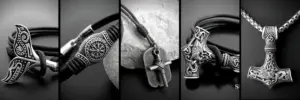
Hermod’s Role and Significance
Swift Messenger and Guide
In Norse myth, Hermod’s cardinal role is as a messenger. The gods relied on him to quickly and reliably carry critical communications between worlds and deliver news, warnings, and other key knowledge.
His talents included not just speed, but discernment to comprehend crucial messages, and exceptional wayfinding skills to traverse difficult terrain and pass through barriers between realms.
As a godly courier, Hermod would have conveyed missives related to affairs and events of significance among deities and humans: tidings of peace and war, love and tragedy, comings and goings among the Nine Worlds.
Equipped with unerring direction-sense and great daring, Hermod ventured where few others would go. He navigated the dark, helical valleys leading to Helheim and leapt easily over its forbidding gates. Such acts required precision and nerve equal to his swiftness.
So in essence, Hermod’s role reflects mastery of travel between planes of existence – a key element of Norse shamanistic tradition. Like a consummate shaman, he shifts fluidly across cosmic layers, operating as an emissary and guide.
Psychopomp Connecting Life and Death
Related to his talents as an interplanar messenger, Hermod also attends to transitional states between life and death. In the account of God King Haakon’s honorable death in battle, Hermod stands ready in Valhalla to greet the slain and usher warriors into Odin’s martial afterlife hall.
Likewise when attempting to retrieve Baldr from captivity in Hel’s dark realm, Hermod aims to engineer a resurrection and restore passage back to the realm of the living. So he mediates between planes, overseeing the soul’s journey in both directions across that permeable veil.
In this psychopomp role, helping departed spirits shift out of Midgard at life’s end and transition into the next phase of their mythic existence, Hermod again echoes Odin, who serves a similar function in collecting worthy dead warriors for his eternal army.
So while the extent of Hermod’s individual power remains unclear, he demonstrates a mastery of cosmic navigation and soul guidance much like the ravens, valkyries and other extensions of Odin’s might.
Appearance and Personality Traits
Snorri describes young Hermod as “Odin’s swain” or attendant. This youth underscores his quickness and vivacity while emphasizing Hermod’s lower status compared to the Father God.
Still, Hermod merits enough trust from Odin to ride Sleipnir, the famed eight-legged steed reserved for Odin’s personal use. So the Allfather clearly depended on nimble Hermod’s talents to accomplish vital tasks in various realms.
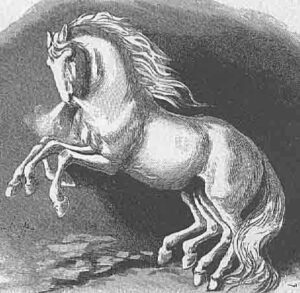
Myths and legends stress Hermod’s loyalty, focus, and unwavering dedication to duty. For example, he volunteers without hesitation for the daunting quest to ride to Helheim and negotiate Baldr’s release from the underworld goddess, showcasing his courage and fraternal dedication.
Unlike trickster figures like Loki or even the cunning Odin himself, Hermod tends to tackle problems directly without guile or deception. While his motive likely aims to resurrect Baldr and restore divine order, Hermod pursues this straightforwardly by petitioning Hela on the merits of Baldr’s case.
However, while acting in good faith as supplicant, he does show cleverness in vaulting skillfully over Hel’s gates. So Hermod balances honest dealing with shrewd skill. This makes him an apt foil and accomplice for craftier gods who may rely on his talents to achieve their own complex ends.
The Myth of Hermod’s Hel Ride
The most famous Norse myth involving swift Hermod is his ride to Hel on Odin’s eight-legged steed Sleipnir in a quest to resurrect his brother Baldr after Loki engineers the slaying of the beloved god of light.
When Baldr perishes and the gods stand stunned in weeping disbelief, Frigg eventually rouses herself to propose a plan for getting Baldr back to defeat death. She asks for a volunteer willing to ride to Hel and beg the goddess Hela to release Baldr from her cold underworld domain.
Brave Hermod readily steps forward to accept the challenge. He mounts Odin’s prized stallion Sleipnir, and for nine dark nights plunges into deep, helical valleys to reach the Gjöll bridge leading into Hel’s realm.
The valiant goddess Móðguðr who guards Gjöll directs him onward through perilous passageways. Hermod persists undaunted through the gloom until finally leaping over the gates of Hel’s stronghold.
In Hel’s great hall he finds Baldr occupying the seat of highest honor. Hermod urgently petitions Queen Hela to let Baldr return, arguing that his death has plunged all the gods and realms into inconsolable grief.
Moved by his words, Hela agrees to release Baldr on one condition – everything in the universe, living or dead, must weep for Baldr to show the depth of sadness over his demise. Then she accepts gifts and tokens from Baldr and Nanna to send back to Odin and Frigg in Asgard.
Hermod quickly returns bearing Hela’s terms and Baldr’s farewell trinkets Draupnir and Nanna’s linen robe. And the gods eagerly set about entreating all things to shed tears that will secure Baldr’s freedom.
Unfortunately a lone giantess named Þökk refuses, and her dry eyes doom Baldr to remain confined in Helheim. Still, the myth powerfully established swift Hermod’s capability and nerve as the gods’ courier crossing into death’s dark empire.
While Snorri likely crafted key elements of this tale missing from earlier sources, its completeness indicates he drew on traditional material now lost. And it aligns well with comparable quest myths from Old Norse lore. So the legendary ride of faithful Hermod stands as a highlight of medieval Icelandic re-tellings of pagan mythic tradition in the 13th century.
Other Hermod Mentions in Norse Literature
Beyond Snorri’s accounts in his “Prose Edda,” Hermod receives minor treatment in other Old Norse-Icelandic texts. References range from confirming his divine status to suggesting he was once viewed as human:
Hákonarmál – This 10th century skaldic poem has Hermod and possibly Bragi greeting newly dead warrior kings as they enter Valhalla. His role welcoming heroic spirits to Odin’s martial hall echoes guidance to an afterlife existence.
Hyndluljóð – In this section of the Poetic Edda, Hermod appears with the human hero Sigmund receiving gifts of armor and weapons from beneficent Odin. Scholars interpret this as either showing Hermod’s initial status as a human warrior rather than a god, or Odin rewarding two distinguished human servants.
Beowulf – The Old English saga references a Danish ruler named Heremod who endures long exile and hardship, reminiscent of Hermod’s adversity in difficult voyages to other realms. So Heremod may share mythic roots as an Odin-esque warrior temporary cast out from society.
These scattered references indicate Hermod’s role lacked consistency across different eras and traditions of Germanic literature. But in the grand scheme, he consistently retains attributes as a wandering warrior spirit allied with Odin in overlapping duties guiding souls and spanning cosmological realms.
Relationship to Other Key Figures
Kinship With Odin and Baldr
As a son of Odin, brother of Baldr, and ally of Thor, Hermod links to the most prominent gods in Norse myth.
Odin – Hermod’s talents and journeys relate him intricately to the Father God. He replicates Odin’s mystical shamanistic transitions between worlds. And his psychopomp activities echo Odin gathering fallen heroes to Valhalla’s eternal reward.
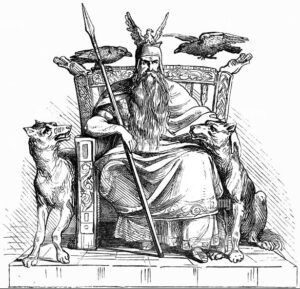
Odin
So while Hermod clearly follows Odin’s directives, certain deeds show him a master in his own right competently expanding the Allfather’s powers across dimensions.
Baldr – Though Baldr and Hermod’s personalities differ starkly, their bond plays a pivotal role. Devoted Hermod risks all to rescue beloved Baldr from the land of the dead. His feat speaks to the close filial link between Odin’s sons, and shows Hermod as a god of action when the other paralyzed deities stand helpless in their grief.
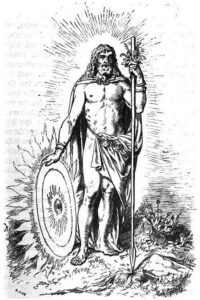
Baldur
Parallels With Hermes and Horpheus
Scholars point to Hermod’s conspicuous similarities to the Greek god Hermes.
- Hermod was known for his speed and role as a messenger or courier between worlds like the Greek god Hermes. Both served as fleet-footed messengers and escorts across dangerous thresholds. Hermod’s name even resembles “Hermes,” pointing to archetypical messenger gods in Indo-European myths.
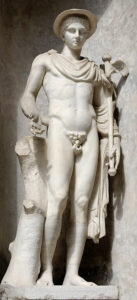
Hermes Ingenui (Vatican Museums)
- However, while Hermes was more mischievous, Hermod was portrayed as solemn, noble and favoring direct action. And Hermod’s shamanic journeys between cosmic realms differ from Hermes gliding over earthly terrain. Still, they share essential attributes as messenger gods.
- In riding to Helheim to retrieve a loved one, Hermod echoes Orpheus’s quest for Eurydice in Greek myths. Both relied on persuasion and devotion rather than force. Yet Hermod rode Sleipnir while Orpheus went on foot, and only Orpheus briefly succeeded.
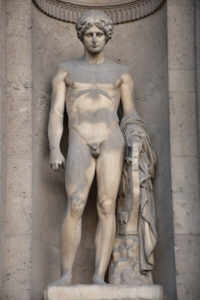
Orpheus’s statue Paris
- So while sharing key traits with Hermes and Orpheus, Hermod has unique elements – like his ride on Odin’s magical steed and failure to fully resurrect Baldr – that set him apart as a Norse hero. Though linked to Greek counterparts, his courageous ride to Helheim remains a distinctive Norse tale.
- Other key roles for Hermod include serving as a psychopomp guiding dead warriors to the afterlife, and attempting to engineer Baldr’s full resurrection from death. So bridging the realms of life and death is Hermod’s defining attribute in Norse legend.
Hermod’s Fate at Ragnarok
Ragnarok – the doom of the gods and end of the known worlds – fills Norse legend with lavish details about the fates meeting major gods as this apocalypse unfolds.
Warriors like Odin, Thor, Tyr and Freyr perish after killed by monstrous adversaries. Gods such as Loki and Heimdall slay one another. And calamities like the enormous wolf Fenrir swallowing Odin whole get depicted in vivid terms.
Yet no account survives to document Hermod’s own demise in the cataclysm. The sources stay conspicuously silent about his participation in the twilight of the gods after centuries of prophesied strife unleash horrors bringing destruction upon them.
So unlike his divine kinsmen, Hermod’s role and destiny at Ragnarok remain a mystery with numerous scenarios left open to speculation:
- Did heroic Hermod die bravely fighting during the chaos of Fimbulvetr and war leading to Ragnarok?
- Might he have continued functioning as a psychopomp, guiding doomed gods and einherjar to the next incarnation of the world?
- Could crafty god have found an escape route from the death and flames obliterating the Nine Worlds?
- Or did he meet such an inglorious end that scalds and chroniclers decided the details merited no preservation through the oral tradition?
In the absence of evidence from surviving texts, the ultimate fate of swift Hermod – Odin’s intrepid messenger son – hides forever behind the veils of mythic history. Like the wily Allfather himself, Hermod slips away elusively in the end.
Hermod’s Modern Influence and Interpretations
As with many minor Norse gods, Hermod’s modern cultural impact proves sparse compared to headliners like Thor and Loki. Without the hammer-hurling thunder god’s raw power or notorious trickster’s flashy flair, the steadfast messenger makes for far less flashy modern adaptations.
Still, with resurgent interest in Old Norse mythology and renewed mining of legends for media inspiration, a niche exists for unearthingDimension-hopping sci-fi or fantasy could draw extensively on Hermod’s talent traversing worlds and realms. And the heart-stirring loyalty shown between the god brothers suggests rich territory for emotive drama.
So influences may accumulate gradually over time. As of recent decades, most examples utilizing Hermod fall into categories like literature or RPG gaming rather than mass entertainment. But the swift god surely still has rich veins left to prospect for 21st century storytelling.
Potential directions for modern reinterpretation include:
Fantasy Fiction and Mythic Literature – Hermod’s mythic accounts already read like fantasy adventure, with an archetypal brave quest into magical danger on behalf of loved ones. Extending his travels among dwarves, giants and dusky underworlds opens lots of imaginative directions.
Comics and Graphic Novels – Visual media could capture wonderfully the extremes of scenery and motion during Hermod’s breakneck ride across the Norse cosmos. Panels alternating bleak gorges of Helheim with the golden glow of Asgard would make for high visual contrast.
Video Games – The goal-driven nature of video games fits perfectly with mythic quests and journeys. Hermod’s ride provides ready-made context for a vivid adventure path blocked by menacing terrain and supernatural gatekeepers.
Neo-pagan Faith Practice – Just as lore about Odin and Freyja see adoption in Norse neopagan sects, Hermod could find renewed purpose for followers seeking icons representing swift travel and guidance between realms of existence.
So with the lingering influence of Norse myth through pop culture and spiritual seekers, lively Hermod may keep galloping across our collective consciousness for years yet to come.
FAQs about Hermod
What is Hermod the god of?
Hermod is the god of messengers, communication, and crossings between realms in Norse mythology. His main role is as a swift courier delivering important messages between the Norse gods and traversing difficult terrain between worlds.
What does the name Hermodr mean?
The Old Norse name Hermóðr means “warrior spirit” or “courage of the army,” pointing to attributes of bravery, energy, and dedication that define Hermod in the myths and literature.
Are Hermod and Hermes the same?
No, Hermod is a figure from Norse mythology while Hermes is the messenger god in Greek myths. But they share similarities in function and name that suggest a common Indo-European archetype for such fleet-footed divine couriers.
Is Hermod related to Thor?
Yes, as a son of Odin, Hermod would be considered a half-brother to Thor within the complex Norse divine family tree. But they do not have many direct interactions featured in the surviving myths and legends.
Who is the fastest god in Greek mythology?
Hermes is described as the fastest Greek god. He wears winged sandals and a hat that enable him to travel with great swiftness in his role carrying messages across land, sea, and between realms.
How did Hermod travel to Helheim?
Hermod rode the swift eight-legged horse Sleipnir, owned by Odin, when journeying to the underworld realm of Helheim on his legendary quest to rescue the deceased god Baldr.
What does Hermod’s journey represent?
Beyond the literal travels, Hermod’s voyage to retrieve beloved Baldr from the clutches of death symbolizes the quest to restore order and meaning in the face of tragedy. It speaks to overcoming adversity through love and determination that transcends the mortal realm.
Does Norse myth say how Hermod died?
No, in contrast to the specific fates related about most major Norse gods at Ragnarok, the destructive end of the world, the lore is conspicuously silent about Hermod meeting his demise, leaving an intriguing mystery.
Conclusion
In the Norse mythic corpus, swift Hermod earns his reputation from a single valiant quest to the land of the dead seeking resurrection of his brother Baldr. By leveraging shamanistic transit between worlds, the brave messenger strives to restore order after tragedy strikes the gods.
While details of Hermod’s origins and fate remain shrouded in uncertainty, his defining journey resonates through medieval literature into enduring legend. And as an extension of Odin’s power projection across dimensions, the agile god of wayfaring and courage fitfully carries out the Allfather’s commands – even into thegloom of Helheim from which most dare not return.
So the unsung story of lively Hermod traces a compelling arc binding life, death and rebirth in Norse cosmology. Obscure he may remain beside gaudy Thor and Loki, but his mythic travels tug meaningfully at archetypal heartstrings still echoing today. For paths he blazed past monstrous abyss and into eternity speak to the very cycle that defines gods and humans alike as we each ride tides of Fortune in turn.
Shop Norse Jewelry
Are passionate about Norse Mythology?
Finding the ideal piece of Norse Jewelry can be challenging and time-consuming, especially if you lack inspiration or don’t know where to look.
Surflegacy, has you covered. We have a wide range of Handmade Jewelry in various styles, shapes, colors, and materials, to accentuate your Norse spirit and look. Do not hesitate to visit our selection HERE
Whatever you wear, you’ll find the ideal trendy piece to complement your wardrobe. Our jewelry is designed to be worn every day, no matter where you go or what season is. Are you ready to step up your wardrobe game?

